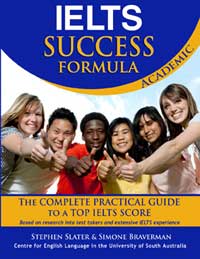IELTS Success Formula Challenge Day 3
Welcome to IELTS Success Formula Challenge Day 3. If you’ve just joined IELTS-Blog today, read about the Challenge here.

“I have a few problems with the Reading sub test. I usually get confused with question types like True/False/Not Given, matching information and completion type of questions. Time management is also a problem, I have never been able to answer all the 40 questions in one hour.”
How IELTS Success Formula can solve Raminder’s Reading problem

This is why we devoted a lot of attention to this issue in IELTS Success Formula – and I quote:
“Question. What if I’m almost out of time, and I still haven’t answered all the questions?
Answer. This can (and probably will) happen to you during the first practice sessions. The IELTS Reading test is time-intensive, meaning there is a lot of reading and answering in the 60 minutes, and anyone who doesn’t manage their time can end up in this situation. While it’s OK to run out of time at home, in the initial stages of your preparation, try not to let it happen to you during the actual exam. Proper time management will help you avoid such scary moments – please refer to
‘7 Fundamentals to Make Your Reading Test a Success’ on page 48.”
I will briefly mention here the 7 Fundamentals (because explaining these principles takes quite a few pages in the book):
1. Skim and scan instead of reading word by word
Did you know? ‘Skimming’ means reading fast to get the general idea and ‘scanning’ means looking for particular information. In the book we explain in detail which question types require skimming, and which require scanning, and then direct you to fitness activities to practice.
2. Use the text to guide you to the answers
This fundamental is talking about a few particular question types that appear in a sequential order in the text. You can save time if you know when you won’t have to go back in the text to find the next answer, you will always be moving forward.
3. Use words from the text
There are particular question types that require copying words from the text “as is”, which is a great – because you don’t even have to worry about spelling or grammar.
4. Read in detail only if you have to
When you know which question types don’t require reading in detail you can save time by scanning.
5. Pay close attention to task instructions in the test paper
If you write correct answers in more words than allowed, you will lose marks.
6. Know when to move on
Some questions are just harder than others. Don’t get stuck on a hard question, move on and keep answering the following ones – your score will benefit from this approach.
7. Manage your time
To manage your time well in the Academic Reading sub test you basically need to do two things:
1. Allocate a certain amount of time to each passage. Since the first passage is normally the easiest it makes sense to allocate the least time to it, then a bit more time to Passage 2, and even more time to Passage 3.
Note: this strategy will work better for people with stronger reading skills, but in the book we also offer an alternative strategy for those who have weaker reading skills.
2. Answer the questions on each passage in the most efficient and accurate way to save time. Because this is important, in IELTS Success Formula we give you techniques for answering the difficult question types quickly and accurately.
For example, Raminder mentioned True/False/Not Given questions confusing him. Here’s how we suggest to approach this question type.
The basic rule is that that if the statement clearly agrees with text, the answer is True, if the statement explicitly contradicts the text, the answer is False, and if the statement says something that the text doesn’t say, it’s Not Given. It works in a very similar way with Yes/No/Not Given.
Also, keep in mind that the answers to True/False/Not Given and Yes/No/Not Given questions appear sequentially in the passage. This narrows down the search for you, because once you’ve found the answer to question 1, the answer to question 2 will be somewhere in the sentences that follow, not in the preceding part of the text.
To learn more visit the IELTS Success Formula webpage and download a free trial copy (scroll down and look for the download link).

 “I took the IELTS test about half a year ago and I got Band 6, which is OK, but not enough for my purpose. I am a pharmacist moving to the UK soon and I need to score Band 7 at least in order to have a proper job opening there.
“I took the IELTS test about half a year ago and I got Band 6, which is OK, but not enough for my purpose. I am a pharmacist moving to the UK soon and I need to score Band 7 at least in order to have a proper job opening there.